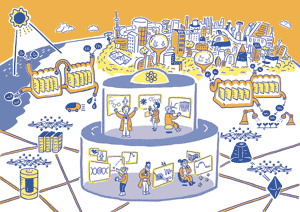Program

Moonshot Goal 6Realization of a fault-tolerant universal quantum computer that will revolutionize economy, industry, and security by 2050.
Program Director (PD)KITAGAWA MasahiroDirector, Center for Quantum Information and Quantum Biology, The University of Osaka
Outline
While it is said that the progress of conventional computers is reaching its limits, it is important to be able to respond to the explosion of information processing demands. If we want quantum computing to rapidly solve our numerous and complex social problems, we need a fault-tolerant universal quantum computer that can perform precise computation while correcting quantum errors. In order to realize such a fault-tolerant universal quantum computer we are conducting R&D into the relevant hardware, software, networks, and related quantum technologies.
A Vision of Society in 2050 (Illustrated Guide)
What might the future look like in 2050 if Goal 6 is realized? An illustrated guide.
Message from PD
In order to realize a fault-tolerant universal quantum computer, it is necessary to integrate a huge number of qubits, provide redundancy using quantum error correcting codes, and reduce the physically arising quantum error to below the fault-tolerant threshold. Therefore, we aim to develop a certain scale of quantum computers and demonstrate the effectiveness of quantum error correction.
Considering the possibility of massively integrated quantum computers through quantum communication, R&D projects will be implemented in three categories: ‘1) hardware’, ‘2) communication networks’, and ‘3) theory and software’. Specifically we would like R&D projects in each category to compete for feasibility, collaborate across categories, and conduct R&D to achieve the Moonshot Goal.
R&D Projects
Selected in FY2020
| Project Manager |
KOASHI Masato
Professor, Graduate School of Engineering, The University of Tokyo |
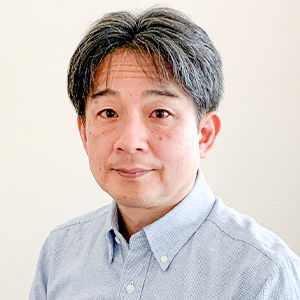 |
This project aims to construct a co-design model encompassing qubit design, fault-tolerant architecture, and compilers and programming languages for efficient computation through collaborations of researchers in quantum information, architecture, and specific physical systems, thereby endeavoring to realize a large-scale quantum computer by the year 2050.
|
| Project Manager |
KOSAKA Hideo
Director, Quantum Information Research Center/Professor, Faculty of Engineering, Yokohama National University |
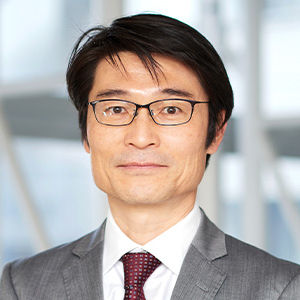 |
This project aims to develop a quantum interface in which quantum memory is combined with an optomechanical crystal, in order to connect the superconducting qubit and the communication photon, towards realization of a large-scale superconducting quantum computer by 2050.
|
| Project Manager |
TAKAHASHI Hiroki
Assistant Professor, Experimental Quantum Information Physics Unit, Okinawa Institute of Science and Technology Graduate University |
 |
This project aims to develop ion trap devices that facilitate building large-scale systems beyond the limitations posed by conventional approaches. The new approach is based on a novel idea of photonically interconnecting multiple ion traps. Thereby we aim to realize large-scale quantum computing by 2050.
|
| Project Manager |
FURUSAWA Akira
Professor, School of Engineering, The University of Tokyo/Deputy Director, Riken Center for Quantum Computing, Riken |
 |
This project aims at the realization of large-scale fault-tolerant universal quantum computers based on a “quantum look-up table” by 2050, which work at room temperature. Here, the “quantum look-up table” is originally developed by ourselves.
|
| Project Manager |
MIZUNO Hiroyuki
Corporate Chief Researcher, Project Leader of Quantum Computing Project, Laboratory Manager of Hitachi Kyoto University Laboratory, Research & Development Group, Hitachi, Ltd. |
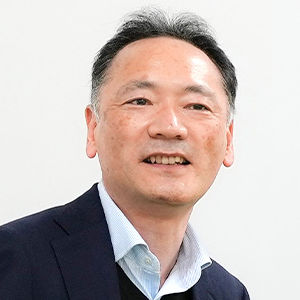 |
This project aims to achieve large-scale integration of silicon qubits by utilizing silicon semiconductor integrated circuit technology. By 2050, we aim to achieve a large-scale quantum computer featuring high integration and low power consumption.
|
| Project Manager |
YAMAMOTO Takashi
Professor, Graduate School of Engineering Science/Deputy Director, Center for Quantum Information and Quantum Biology, The University of Osaka |
 |
This project aims to develop elemental technologies for networking quantum computers with photons, atoms, semiconductors and so on, aiming to network small and medium quantum computers. We further promote networked quantum computers on a larger scale towards the achievement of universal quantum computation by 2050.
|
| Project Manager |
YAMAMOTO Tsuyoshi
Research Fellow, Secure System Platform Research Laboratories, NEC Corporation |
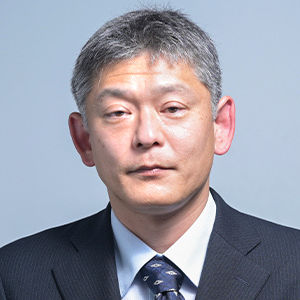 |
This project aims to develop hardware technologies required for scaling up the circuit of superconducting qubits in order to accelerate R&D of superconducting quantum computers. Using these technologies we aim to realize large-scale superconducting quantum computers by 2050.
|
Selected in FY2022
| Project Manager |
AOKI Takao
Professor, Faculty of Science and Engineering, Waseda University |
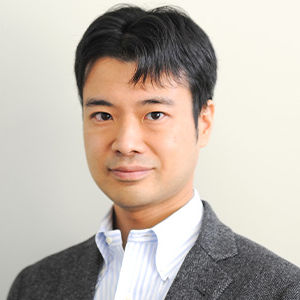 |
This project aims to develop novel quantum-computing hardware based on nanofiber cavity QED. By 2050, we aim to develop large-scale distributed quantum-computing hardware and to realize a fault-tolerant universal quantum computer and a quantum internet.
|
| Project Manager |
OHMORI Kenji
Professor/Chairman, Institute for Molecular Science, National Institutes of Natural Sciences |
 |
We will implement a “dynamical qubit array” in which a large number of cold-atom qubits are assembled with optical tweezers, and each of them is moved arbitrarily and at high speed to perform gate operations as well as error detections and corrections. Furthermore, under close industry-academia collaborations, all components will be integrated and packaged to achieve unprecedentedly high stability and usability. Through these innovations, we aim to realize a fault-tolerant quantum computer that will revolutionize economy, industry, and security by 2050.
|
| Project Manager |
KOBAYASHI Kazutoshi
Professor, Department of Electrical and Electronic Engineering, Kyoto Institute of Technology |
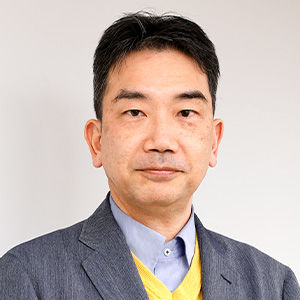 |
To realize an error-tolerant general-purpose quantum computer, this project addresses the technical issues of algorithms and scalable backends for classical hardware for error correction, scalable quantum-to-classical input/output frontends, semiconductor chips for backend/frontend, and cryogenic operation of optical integrated circuits for high bandwidth and low power quantum-classical input/output. Our challenge will be a technical breakthrough to implement a general-purpose fault-tolerant quantum computer by 2050.
|
| Project Manager |
TARUCHA Seigo
Group Director, RIKEN Center for Emergent Matter Science /Team Leader, RIKEN Center for Quantum Computing |
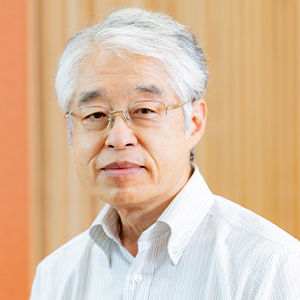 |
This project aims to develop scalable technologies for Silicon quantum computer. We will use sparse integration and medium-distance quantum coupling to implement a unit structure of qubits and scale up the qubit system by increasing the number of the unit structures. Based on this method we will develop fundamental technologies appropriate to implement large-scale quantum computers by 2030, and expand the technologies in cooperation with the semiconductor industry to implement universal quantum computers by 2050.
|
| Project Manager |
NAGAYAMA Shota
Associate Professor, Graduate School of Media Design, Keio University |
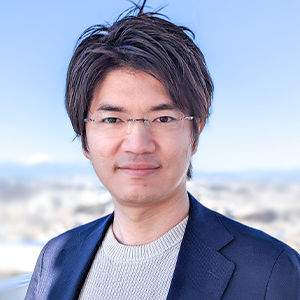 |
In this project, we will build a testbed for a general-purpose quantum communication network, which is a key technology for distributed large-scale quantum computers, and integrate hardware and software to demonstrate the principles and technologies of communication architectures and protocols with a view to actual operation. The results of this project will lead not only to distributed large-scale quantum computers but also to the quantum Internet, and will contribute to the realization of a world in which quantum information can be freely generated, distributed, and processed.
|
Advisors
Click here to see the list of advisors
| KOZUMA Mikio * |
Director / Professor, Quantum Navigation Research Center, Institute of Integrated Research, Institute of Science Tokyo |
| NAKAMURA Yasunobu * |
Professor, School of Engineering, The University of Tokyo |
| YAMASHITA Shigeru * |
Professor, College of Information Science and Engineering, Ritsumeikan University |
| ISHIUCHI Hidemi |
Former President, Evolving nano process Infrastructure Development Center, Inc., EIDEC |
| IMOTO Nobuyuki |
Senior Professor, Office of Senior Professor, The University of Tokyo |
| UTSUNOMIYA Shoko |
Principal Solutions Engineer, Go To Market, OpenAI Japan G.K. |
| OZAWA Masanao |
Professor Emeritus, Graduate School of Informatics, Nagoya University |
| KAWABATA Shiro |
Professor, Faculty of Computer and Information Sciences, Hosei University / Fellow, Technology and Innovation Strategy Center, NEDO |
| SASAKI Masahide |
Distinguished Researcher, Open Innovation Promotion Headquarters, National Institute of Information and Communications Technology |
| SHIGEMOTO Isamu |
Executive Engineer, Technology and Innovation Center, Daikin Industries, Ltd. |
*Sub Program Director
Goal 6 News
Contact
Goal 6 Secretariat
Department of Moonshot Research and Development Program, Japan Science and Technology Agency
e-mail moonshot-goal6 jst.go.jp
jst.go.jp


